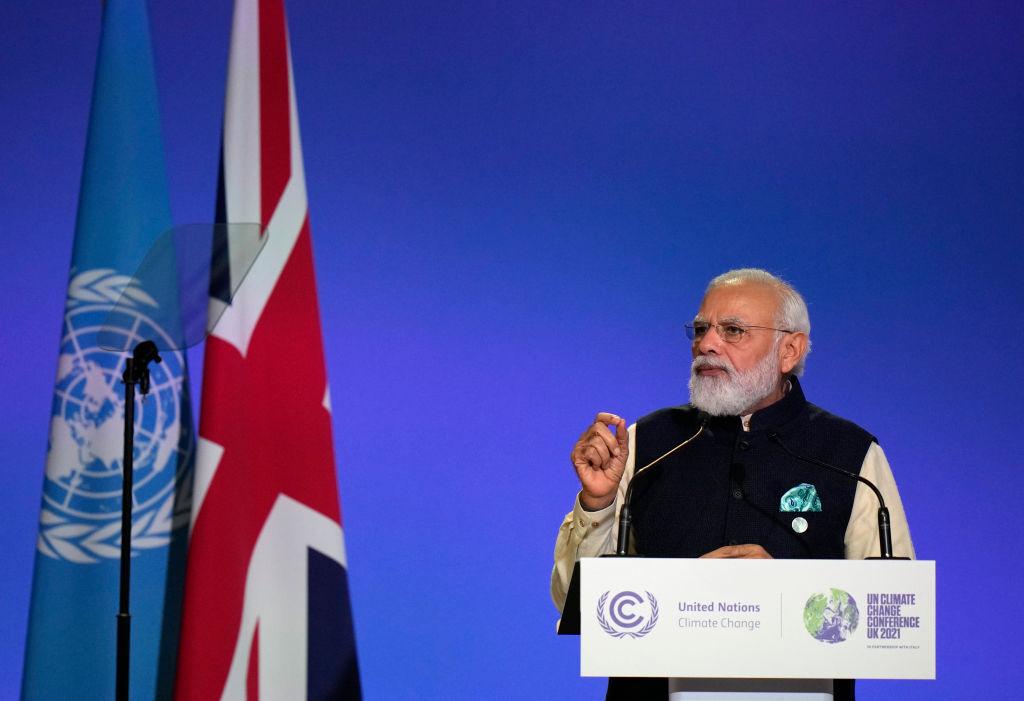
World leaders have now departed Glasgow after delivering, with a few notable exceptions, underwhelming climate announcements. If COP26 was the planet’s last best chance, leaders for the most part didn’t rise to the occasion. But the conference is not over—from now through 12 November, officials and negotiators will be working around the clock to flesh out and perhaps improve on the commitments made by the heads of state.
There is much for them to build on. In the lead-up to Glasgow, almost 70 countries had committed to net-zero emissions targets, including China, the world’s largest carbon emitter. The standout announcement at COP26 was from Indian Prime Minister Narendra Modi. He committed his country to net zero by 2070—the first time India has committed to an emissions-reduction target.
This means that India may be able to peak emissions by 2030, but it’s difficult to be definitive on that in the absence of an official baseline prediction of its future emissions. According to some estimates, hitting the 2070 target means India’s emissions will have to decrease by 15% overall.
Even more ambitious was Modi’s pledge to increase the country’s non-fossil-fuel energy capacity to 500 gigawatts by 2030 and increase the share of renewables from 40% to 50% by 2030. That’s really big news because, if these efforts are successful, 70% of India’s installed electricity capacity will be non-fossil-fuel based. The 50% renewables target goes much further than the 38% that could be achieved in India by market forces alone, according to the Energy Policy Simulator.
Right now, all of this looks difficult to pull off. But for Modi the political wins are obvious. The announcements transmit a clear signal intended to attract more of the global finance massing behind the transition away from fossil fuels. India can only benefit from the jobs and sustainable growth that this will bring. And India’s government-driven electrification of transport and industry will be hugely popular domestically if it results in a drop in energy and fuel costs across the board and a steep improvement in the extremely poor air quality in India’s major cities.
Modi’s targets will require a massive investment in a new green supergrid for India, which the UK will partner with India to build. This was part of a signature UK–India proposal to spearhead green supergrids across the planet to offset local renewable intermittency. The geopolitics and regulatory requirements of this proposal will be interesting, but India is a great place to start.
Fossil-fuel producers have hoped that they can replace declining revenues from developed economies by selling into emerging markets like India. But with government-backed renewable targets like the ones Modi just announced, the risks for fossil-fuel investment will only grow and might also help divert investment from fossil fuels to renewables elsewhere in the developing world.
India’s new commitments, combined with the net-zero pledges made by countries prior to COP26, represent a big improvement over the Paris climate agreement. If these commitments are actually implemented, we will have a 50% chance of limiting warming to 1.9°C, compared to the 2–4 degrees of warming anticipated just five years ago at the conclusion of the Paris agreement.
The private sector, reflected in the Glasgow Financial Alliance for Net Zero, is also contributing significantly to the momentum. Timed to coincide with COP26, the alliance announced that it was adding a number of major banks and pension funds to its membership, which now represents US$130 trillion of assets under management committed to achieve net zero by 2050.
And the US$8.5 billion Just Energy Transition Partnership that France, Germany, the UK, the US and the EU signed with South Africa could be a model for other energy-transition partnerships with big emitting emerging economies in regions such as Southeast Asia.
Other wins were new agreements to halt deforestation and reduce methane emissions, and the commitment of 20 economies, including the UK, US and EU, to halt financing for all overseas fossil-fuel projects.
But the scale of greenhouse gas reductions necessary to avoid catastrophic climate impacts is enormous and countries often falter in implementing the commitments they make. The two dips in carbon emissions that happened during the global financial crisis and the Covid-19 pandemic are instructive in quantifying the unprecedented scale of cuts required to limit warming to 1.5°C. Essentially, the world requires pandemic-level reductions in emissions each year.
The International Energy Agency’s relatively conservative 2021 report on limiting global warming to 1.5°C argues that most coal needs to be phased out by 2030, with gas and oil not far behind, to achieve 90% renewable electricity by 2050. This means that the credibility of post-COP26 carbon roadmaps, especially from the big coal producers and users such as the US, India, China, Japan, South Korea and Australia, really hinges on how they can demonstrate this phaseout.
Or, if not, they need to explain to their citizens why temperature rises over 2°C—the probable amount of warming if these phaseouts don’t happen rapidly—is acceptable. For those countries, including Australia, that privilege technology over fossil-fuel reduction, it’s important to note that the IEA report has a role for technology like carbon capture and storage, but only in addition to, not instead of, steep cuts in fossil fuels.
The carbon budget is tight, and with every year of insufficient action there’s less room to manoeuvre. The frustration of many global south countries was voiced by Belize this week. ‘For every dollar that my country invests in climate action, G20 countries undo multiple times over with billions of dollars in oil and gas investment,’ Prime Minister Johnny Briceno said.
Overall, this first stage of COP26 demonstrates that governments are still lagging behind markets, civil society and public opinion on climate action. The heightened ambition on display still doesn’t match up to the science. We are getting close, but too many G20 nations are still acting as if climate science is an opening gambit that can be bargained with through incrementalism.